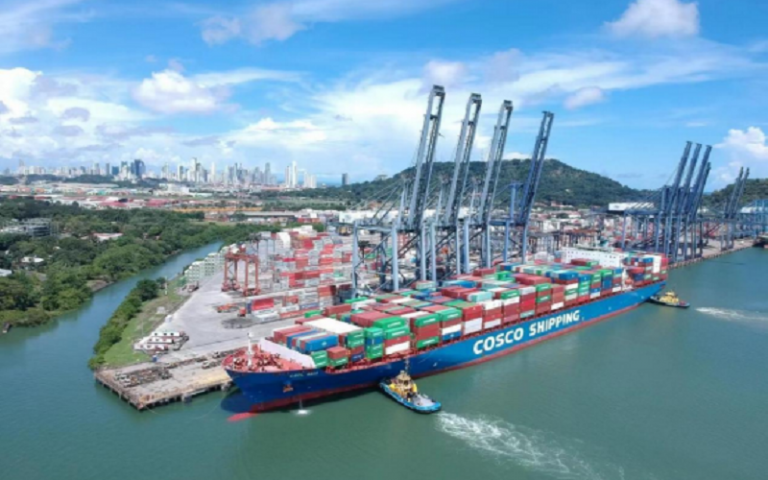
By Shi Yuanhao, Song Yiran, On the vast Pacific Ocean, container ship Jasmine owned by China’s COSCO Shipping Lines was braving the winds and waves.
Upon arriving in Panama city, the ship slowly docked at the Port of Colon, close to the terminus of the Panama Canal on the shores of the Atlantic Ocean.
There, the containers carried by the ship were transferred to an overseas warehouse built by China COSCO Shipping Corporation Limited (hereafter referred to as “China COSCO Shipping”), the parent company of COSCO Shipping Lines, and then distributed to merchants in Latin America and the Caribbean before reaching hundreds of thousands of consumers in the region.
This full-process comprehensive logistics service developed by China COSCO Shipping combines shipping, warehousing and customs clearance. It has made significant contributions to Panama’s employment and shipping industry.
The Colon Free Zone (CFZ) in Panama, one of the world’s busiest FTZs, is located at the Atlantic gateway to the Panama Canal. It boasts an advantageous maritime location and many tax incentives. Re-export trade is its core business.
In October 2020, China COSCO Shipping set up an overseas warehouse in CFZ, covering more than 20,000 square meters, to better leverage the CFZ’s geographical advantage and its shipping line strengths, in response to the growing needs of Chinese companies operating in Latin America.
Wang Zhen, deputy general manager of COSCO Shipping Lines (Panama) Inc., said that the overseas warehouse not only helps remove logistics bottlenecks in Latin America, but reduces overall transportation costs and makes industrial and supply chains stable and unimpeded.
According to Wang, Cargos are kept in the warehouse for quick dispatch and delivery to buyers from Latin America and the Caribbean.
“Cargo traders had to invest a large amount of money in advance, which could only be regained once all the goods were sold. Prolonged shipping time could inevitably lead to significant financial strain,” said Guo Jialun, logistics manager of COSCO Shipping Lines (Panama) Inc.
By reducing delivery times, the warehouse has helped relieve cash flow pressures and has received high appraisals from buyers in Latin America and the Caribbean, Guo added.
“I feel a strong sense of satisfaction every time I think about how we are moving these cargos to other countries and ensuring their safe and efficient delivery to businesses and consumers,” said warehouse supervisor Carlos Bandini of COSCO Shipping Lines (Panama) Inc.
Bandini has been working at the warehouse for more than two years. “The warehouse can secure punctual delivery of goods and achieve considerable cost reductions by implementing streamlined management techniques and adopting the latest technologies,” said Bandini.
China COSCO Shipping has employed a number of local workers at its office and terminals in Panama city. The overseas warehouse in the CFZ alone has created nearly 100 jobs for local residents.
The company is an active supporter of the development of Panama’s shipping industry. It has offered different types of vessel console simulators for local maritime colleges, and worked with these colleges and relevant organizations to provide internships for students.
On the campus of International Maritime University of Panama, there is a building donated by China COSCO Shipping. The university’s simulator and application technology center is also equipped with devices aided by the company.
Panama’s connectivity to the rest of the world is the country’s core competitiveness, said Giovanni Bruno Ferrari, general manager of the CFZ.
“More and more Chinese companies are doing business in Panama, which is further enhancing such competitiveness,” said Ferrari.
According to statistics from the Panama Canal Authority, in the fiscal year of 2023, the Panama Canal saw more than 25 million tons of cargo originating from China and over 39 million tons destined for China, totaling more than 64 million tons, which account for a substantial 22.7 percent of the canal’s total traffic of the year.
Ferrari said China has long been the largest commodity supplier of the CFZ and the second-largest user of the Panama Canal. The vast amount of Chinese commodities shipped to Latin America and the Caribbean via the CFZ not only facilitates the development of the CFZ itself, but also plays an important role in maintaining unimpeded global trade and stabilizing the global supply chain.
Panama is the first Latin American country to sign a memorandum of understanding with China on the Belt and Road Initiative (BRI) cooperation. The two countries have agreed to take the opportunity of aligning the BRI with the National Logistics Strategy of Panama 2030, to strive for more highlights of bilateral cooperation.
Panamanian economist Eddie Tapiero said that Panama, as an international shipping center and regional aviation, logistic and financial hubs, enjoys natural advantages in Belt and Road cooperation. The country will leverage its geographical advantage and play a positive role in deepening Latin America-China cooperation, Tapiero added.
“Belt and Road cooperation has brought tangible benefits to Panama,” said Rogelio Paredes, former minister of Housing and Territorial Planning in Panama. The global connectivity network built by the BRI has significantly promoted global trade, making the geographical advantage of Panama even more prominent, he noted.










